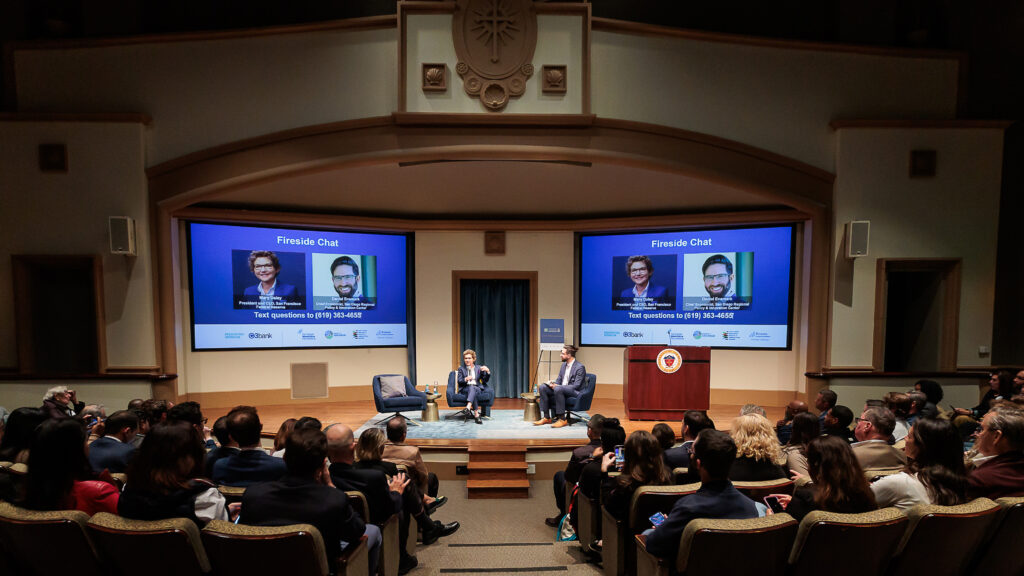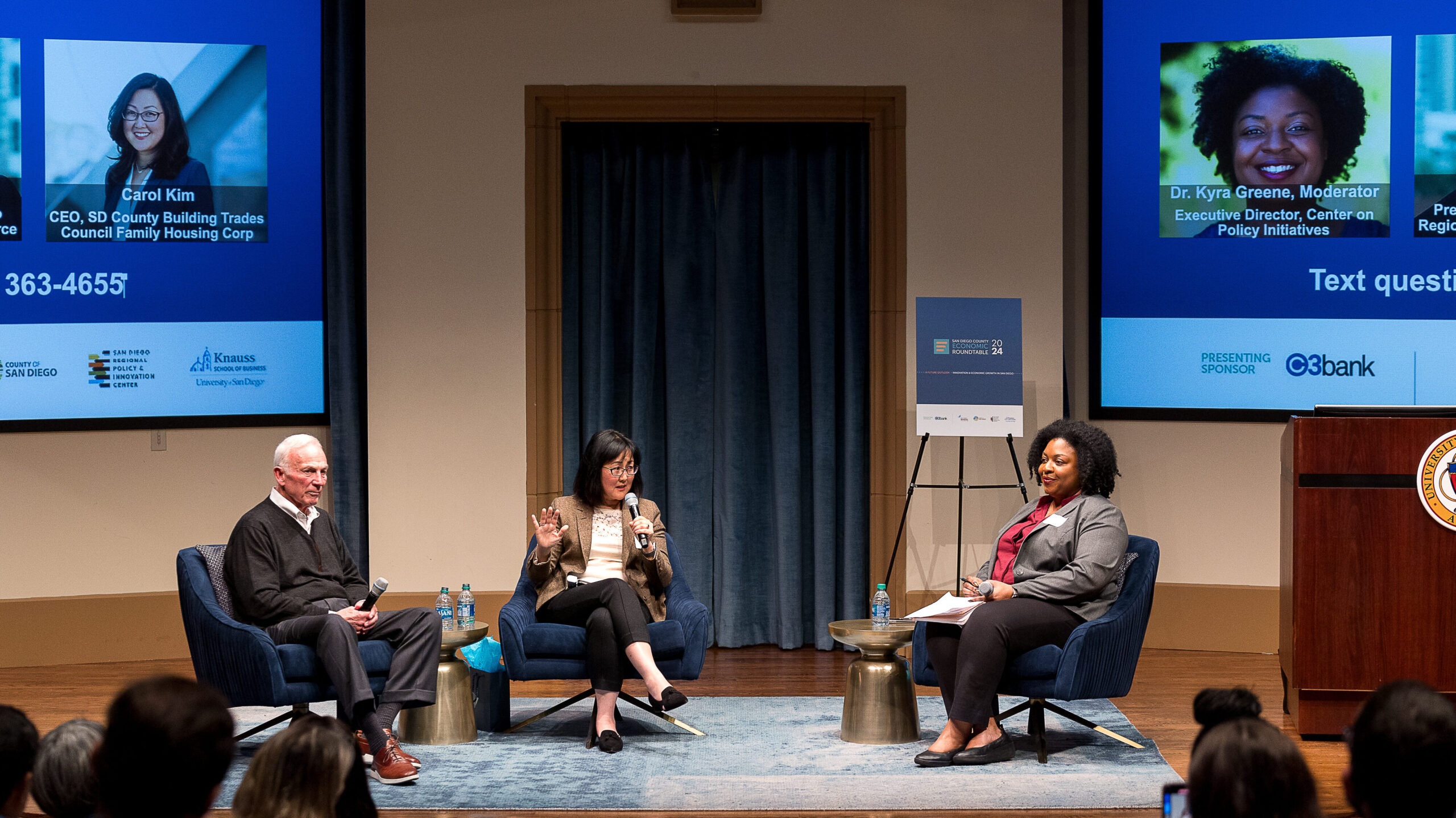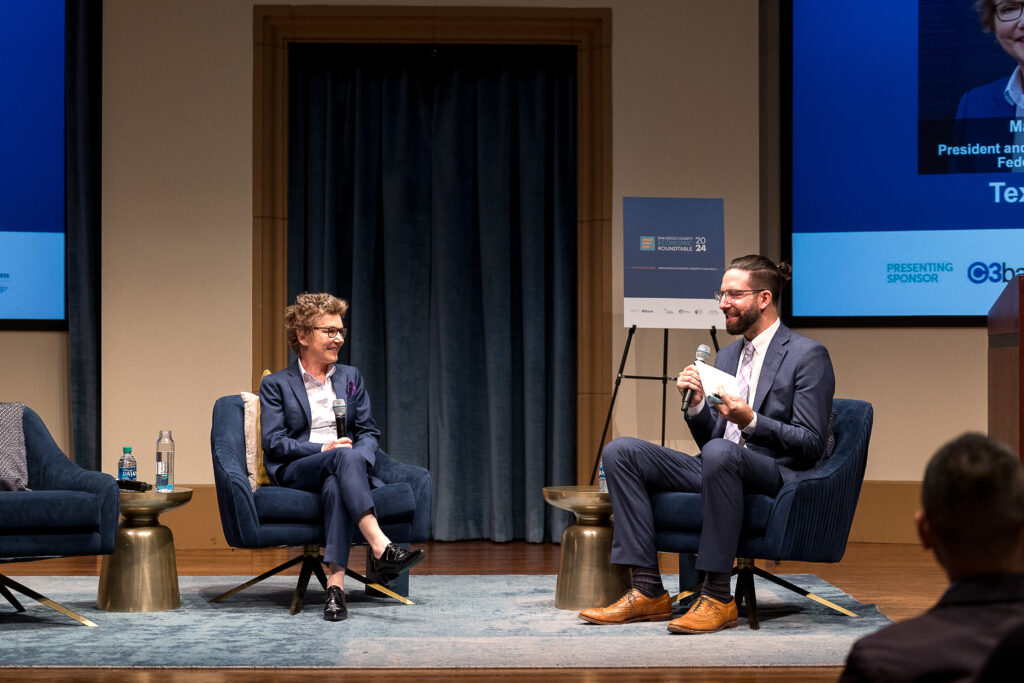
This year’s Economic Roundtable 40th anniversary event served as a dynamic forum providing crucial economic projections and offered insights into pressing issues such as housing, transportation and education.
The Roundtable opened with notable speakers including Chair of San Diego Board of Supervisors, Nora Vargas; Tony Young, Interim President and CEO of the San Diego Workforce Partnership; Rick Virgin, Vice President of University Advancement at the University of San Diego; and A.J. Moyer, President and CEO of C3Bank.
A dynamic fireside chat with Dr. Daniel Enemark of the San Diego Regional Policy & Innovation Center and Mary Daly, San Francisco Federal Reserve President set the tone for the event, providing insights into the local and national job market, inflation, monetary policy and status of workforce equality. In a concluding panel between Jerry Sanders, President and CEO of the San Diego Regional Chamber of Commerce and Carol Kim, Business Manager at the San Diego County Building & Construction Trades Council, moderated by Kyra Greene, Executive Director at the Center on Policy Initiatives, provided a comprehensive exploration San Diego’s—promising though often inequitable—economic landscape.
Below we summarize the main points made regarding the current state of San Diego ‘s economy.
Examining Inflation Dynamics
In early 2023, our economy was experiencing inflation at a high of 6.4%, and through federal policy and other economic maneuvers, it was reduced to 3.4% by the end of the year. During her fireside chat, Mary Daly recapitulates the global pandemic role in the inflation, which she states was ultimately a bad mixture of increase in demand for goods and housing, with a decline in demand for services, reduction in supply and size of the labor force.
She explains further that the stay-at-home COVID-19 mandates caused people who did not leave the workforce to shift their spending from services to goods. With an increase in individuals working remotely, the demand for bigger, more spacious homes increased, which played a factor in the rise of housing prices. These mandates also caused a reduction in the workforce as individuals were laid off due to companies downsizing, or quit—all during a time where demand for essential workers rose—workers like delivery drivers, healthcare professionals, etc.—which caused an unprecedented shift to our economy and resulted in the dramatic rise of inflation.
Carefully Calibrating Inflation to Achieve a Soft Landing in 2024
To battle the raising inflation, the Federal Reserve responded by raising interest rates—what they always do when demand is high. Their action combined with the ending of stay-at-home mandates, along with supply chains recovering, the demand for goods switching back to services and people going back to work allowed inflation to lower more rapidly than it was previously expected. “What most people call the ‘immaculate disinflation’,” Daly says “was actually a purposeful march towards normalization, due to the post pandemic supply chain recovery and normal Federal Reserve policy action in these situations.” This purposeful march was in effort to achieve a “soft-landing”, a term that the Federal Reserve coined to describe the process of lowering inflation down without creating a decline in economic activity.
With the immediate goal of getting inflation down to a more manageable interest rate, the focus shifted back to achieving and maintaining economic stability. Although some economists deemed the goal as reached, Mary Daly cautions against “declaring victory too soon.” “…If we do this”, explains Daly, “then inflation can get stuck at 3.9%.” The Federal Reserve considers an economy stable when inflation is at 2%. How we get to 2% inflation and achieve the sought-after soft landing?
For Mary Daly, who considers herself an “evidence-based optimist,” the current economic landscape is a chance to focus on the Federal Reserve’s main goals of:
- Achieving full employment in which everyone who wants a job, has a job
- Keeping the value of the dollar consistent
- Lowering inflation without raising unemployment
Creating a People-Centered Economy
Another recurring talking point throughout the Roundtable was the need for more inclusive policymaking. Mary Daly’s belief that “every voice, every lens, every perspective matters,” and that “you only make good policy if you’re out there among the people,” emphasizes the significance that effective policies emerge only when policymakers actively engage with the diverse experiences of the public.
Carol Kim underscores the necessity of incorporating people’s lived experiences into economic considerations. She highlights a stark reality where “10% of Americans wealthiest own 93% of all stocks; while the bottom 50% of Americans own 1%, yet many of our economic indicators are set around how the stock market is doing.” Kim emphasizes that the economic outlook must include people’s lived experiences. Kim also notes that 46% of working people do not have any retirement savings, and 2/3 of people over the age of 50 have less than $100,000 saved for retirement.

Kim contended that our economy is a man-made system that was designed to create these inequitable outputs, but stresses that this system can be changed. Regarding equity, Mary Daly believes that “When opportunity is not even, we are leaving talent on the table…closing gaps is not about fairness, it’s about economic wellbeing of society.” To create any meaningful change, she offers the advice that communities need to come together, inviting in people outside of our immediate industries, and creating partnerships between public and private communities to find common ground that will allow us all to align on the same strategic goals.
“When opportunity is not even, we are leaving talent on the table…closing gaps is not about fairness, it’s about economic wellbeing of society.”
Mary Daly

A Need for a Paradigm Shift in Education, Housing and Transportation
Education
San Diego is witnessing a transformative shift in the way individuals gain skills and enter the workforce. Carol Kim highlights the historical narrative that links higher education to increased workforce development opportunities. However, the evolving education-to-workforce landscape embraces alternatives to four-year degrees at corporations, like apprenticeships and unions. These models empower workers collectively, providing earn-while-you-learn and on-the-job training opportunities and job security for the next generation of workers.
A critical aspect is the acknowledgment that not everyone pursues or can afford a traditional four-year college education. Thus, the current focus is shifting towards skills-based training, often offered at no cost to the participant. Community colleges—which fundamentally are intended to be accessible to all—are pivotal in this vision. The shift also relies on employers investing in skill-based training for current employees and future hires. For the shift in skills-based training to be successful, Mary Daly says that “Employers who are interested in skills-based hiring must adopt skills-based metrics and questions and embed them practice into their hiring process.”
Housing
The housing crisis demands a departure from the belief that neighborhoods can’t change. Carol Kim and Jerry Sanders emphasize the need for integrated housing and challenges the “Not in My Backyard” (NIMBY) attitude. A diverse mix of housing-type is essential—apartments, condos, single-family homes—reflecting the multifaceted nature of San Diego.
So how do we create more affordable housing in San Diego? Even with the California minimum wage increases, we still need to address worker wage inequities for sustainable solutions. For Jerry Sanders, it comes down to creating more apartments in neighborhoods. The city has tried different options like proposing SB 10—which did not pass—but even with more housing, many of which come with a hefty price tag, “Every apartment can cost 3k per month,” says Sanders.
Transportation
In the realm of transportation, Jerry advocates for a scientific approach over political posturing. He challenges conventional desires like more lanes on the highway, expounding that “Everyone wants to see more buses because they assume that someone else will take it and everyone wants to see more lanes of the freeway, but then you see more people on the freeway because there’s more lanes.” Carol Kim believes that to make public transportation a viable option, San Diego should mimic other major cities with robust public transportation systems, like New York and Chicago, where car usage is more challenging and expensive.
Unlocking San Diego’s Economic Potential
The conversations during the Economic Roundtable were not just about policy and regulation, but also a call to fundamentally shift the way we think, act and invest in our community. The path forward involves collaborative efforts, innovative solutions and a commitment to creating an economic landscape that benefits all.
